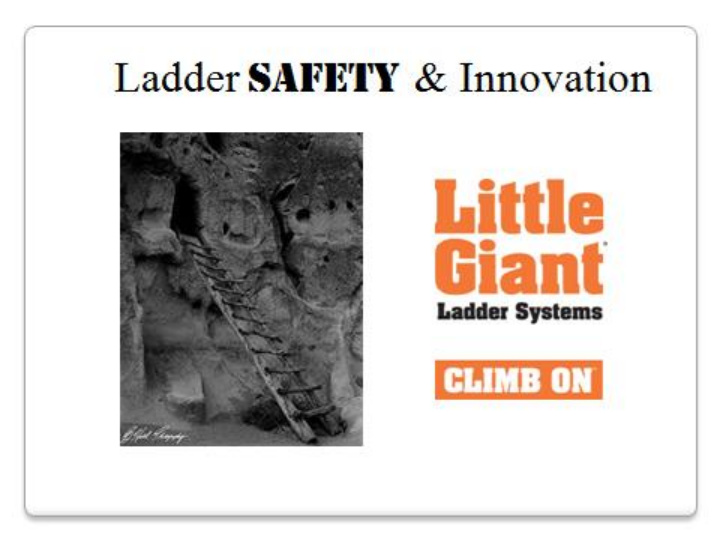



Ladder Safety 101
By the Numbers All Falls Falls off of Ladders • • 2,000 – number of people that go US DOL – Falls are the leading to the hospital every day due to a cause of Occupational Death ladder related incident • 35% of Total Deaths in • 100 – number of workers that are Construction long term or permanently • Typically 700-800 fall fatalities disabled every day from ladder a year. related incident • 1 – number of people that die every day from a ladder related accident • 724,000 ladder related injuries per year • 350 fatalities per year
Types of ladders Multi-purpose Extension Ladder Step Ladder
Material & Rating Wood Fiberglass Aluminum
How much $ to change a light bulb?
#1 – Choose The Right Ladder for the Job.
Ladder Safety 101 Step Ladders Reference OSHA 1910.1053, OSHA 1926.1053 ANSI A14.1, A14.2-1982 and American Ladder Institute • Inspect before each use; tag out damaged ladders • Must be used on level surface. • Never stand on the top rung or top cap of a step ladder What do you • Never lean a step ladder against a structure and use as an extension ladder – Use a 90 degree see in the ladder instead • real world? Do not set up in front of closed doors or in high traffic areas without taking proper measures • Face the ladder when moving up or down • Three Points of Contact • When carrying a ladder, the front end is higher than the back end. • Middle of the body stays between the side rails.
Ladder Safety 101 Extension Ladders Reference OSHA 1910.1053, OSHA 1926.1053 ANSI A14.1, A14.2-1982 and American Ladder Institute • Do not over reach! • Never step on the top three rungs. • Ladder must extend three feet over roof in order to access. • Inspect before each use; tag out damaged ladders What do you • Maintain a 75.5 degree angle for Extension ladders see in the or 1 feet out from wall for every 4 feet of working height real world? • Do not set up in front of closed doors or in high traffic areas without taking proper measures • Set up on level ground, use leg levelers • Face the ladder when moving up or down – “three points of contact” • When carrying a ladder, the front end is higher than the back end. • Middle of the body stays between the side rails.
MEMORIZE THIS - Every Presentation of Every Ladder Starts with this: 3 major causes of Ladder Accidents 3. Falls due to 2. Using the wrong 1. Strains and sprains overreaching – ladder for the job – from handling heavy Most serious accidents More serious ladders- Most leading to permanent common injury, less disability or death serious but most expensive
2. Using the Wrong Ladder Examples • Standing on the top of 6 ft. Step Ladder vs. using an 8 ft. (Using the wrong size ladder). • Using a Step ladder as an extension ladder
3. Overreaching Falls due to overreaching – • Most serious accidents leading to permanent disability or death
1. Preventing Strains and Sprains - Our Select Step ladder has wheels to make moving them around the facility easier. 2. Using the Wrong Ladder – The three sizes of step ladders that are used most often are 6’, 8’, and 10’ models. The Select Step is 6’, 7’, 8’, 9’, and 10’ all in one model. 3. Overreaching – With a standard step ladder, the higher you get the further you get away from your work. The Select Step can be used in a 90 degree position which allows you to face your work and keep your belt buckle between the rails.
GRANDPA’S LADDER
Hierarchy of Control Design It Out Guard Against It Warning Labels, Training, PPE
Problem #1
Problem #2
Problem #3
Other Safety Features: 1. What does the top step of a standard step ladder do? It’s a sticker holder. 2. Air Deck – 3 Point of Contact
How could this worker do this job without the cage? • No harness • Both Hands Available • No Aerial Lift • No Scaffolding
Thank you!
Recommend
More recommend